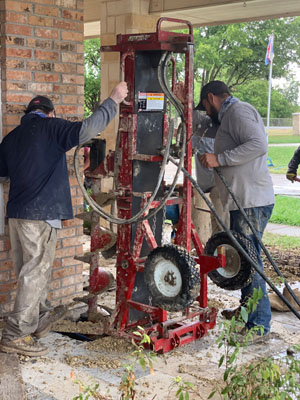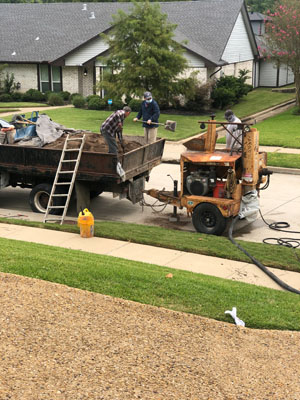Drilled Concrete Piers & Mudjacking
Deep Drilled Concrete Piers
 Longhorn uses only deep drilled concrete piers. Longhorn's deep drilled concrete piers are "not" concrete cylinders pushed into the dirt but rather you would get an actual concrete pier which is drilled to a verified depth, lined with reinforcing steel, and poured in place with high strength concrete.
Longhorn uses only deep drilled concrete piers. Longhorn's deep drilled concrete piers are "not" concrete cylinders pushed into the dirt but rather you would get an actual concrete pier which is drilled to a verified depth, lined with reinforcing steel, and poured in place with high strength concrete.
Deep drilled concrete pier shafts are constructed at uniform intervals (usually about every 6 feet) along the perimeter or interior foundation beams where settling has occurred. A pier shaft is drilled to a depth where the soil is more stable. A steel reinforced concrete pier cap is excavated & tied into but also an integral part at the top of the pier.
After the pier & pier cap have been excavated, cleaned, reinforced with steel, & cured (or hardened) hydraulic jacks are placed on the pier cap and used to raise the foundation to as near level as possible. Solid concrete blocks are then placed between the foundation and the pier cap with steel shims on top used as spacers between the block and foundation. An important advantage of using deep drilled concrete piers is that they are completely adjustable if any future movement should ever occur.
Not only are concrete deep drilled piers recommended by many local Structural Engineers and one of the most cost-effective options for pier installation but when properly installed and maintained they will provide years of trouble-free foundation stability.
"Mudjacking"
 When soils shrink and pull away from a foundation or when piers have been installed and a foundation has been raised a void or gap many times is left under the foundation slab. "Mudjacking" is the process used to fill these voids and restore the uniform bearing over the whole foundation slab.
When soils shrink and pull away from a foundation or when piers have been installed and a foundation has been raised a void or gap many times is left under the foundation slab. "Mudjacking" is the process used to fill these voids and restore the uniform bearing over the whole foundation slab.
"Mudjacking" is accomplished by drilling a series of small holes through the foundation beam or slab and then pumping a concrete slurry (cement/soil mixture or "mud") under pressure beneath the foundation slab in areas where a void exists.


